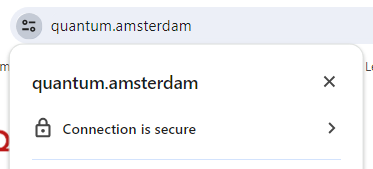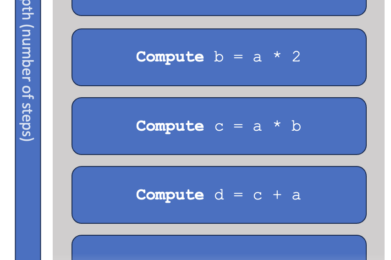The professional’s guide to Quantum Technology
- Preface: Why this guide?
- Part 1 – The background: Why are we so enthusiastic about Quantum Technology?
- Part 2 – The applications: What problems will we solve with Quantum Computers?
- Part 3 – The developments: Searching for a killer application, with a closer look at artificial fertilizer
- Part 4 – The applications of Quantum Networks
- Part 5 – Timelines: When can we expect a useful quantum computer?
- Part 6 – Getting started: What steps should your organization take?
- Part 7 – The hardware: Why you should care about different qubits
- Part 8 – The threat: The impact on cybersecurity
- Part 9 – Scaling up: Why we need error correction
- Further reading: An overview of resources
Part 8 – The threat: The impact on cybersecurity
In the world of quantum computers, the most convincing exponential speedup lies in codebreaking. Anyone who wants to understand the impact of quantum computers, will need to know their basics of cryptography. So let’s start at the beginning.
Cryptography is much more than just ‘encrypting’ your data.
Why do we actually use cryptography? Pretty much everyone will immediately think of:
- Privacy / confidentiality: making sure that others cannot read your data (especially when messages are sent over a network).
However, there are many more threats that cryptography protects us from. Most people wouldn’t normally worry about them, but when any of the following is missing, cybercriminals can cause a lot of harm:
- Authentication: You want to verify that a message really came from the entity that claims to send the message. For example, during online banking, you want to be 100% sure that you are communicating with your bank and nobody else.
Another example is when installing a new piece of software. When executing the latest Windows update, your computer makes sure to check that there is a ‘digital signature’ that belongs to Microsoft. Imagine how unsafe your computer would be if anyone could send fake updates!
- Integrity: You want to verify that nobody changed the message during transit. Imagine what damage could be caused when your emails are maliciously altered before they arrive, or when the commands coming from an air traffic control tower are modified. Similarly, any software installer confirms that the software wasn’t changed by anyone but the original publisher, by verifying a digital signature.
- Establishing secret keys: How do you negotiate a new secret key with a brand new webshop that you never visited before? This is a seemingly impossible task if bare internet traffic can be read by anyone, but modern cryptography has a solution.
There are some others like non-repudiation and availability that we don’t discuss here. Remember the above bold-faced words, as we will come across them a lot more.
We hope that this introduction makes the reader aware of the enormous importance of proper cryptography, and the sheer number of cryptographic checks that are required for proper functioning of our IT. You would be surprised how often you use cryptography on a daily basis, through your laptop, phone, car keys, or smart cards.
The quantum threat is mainly to public-key cryptography.
A common misconception, which we see a lot in popular literature, is that the quantum threat can be summarised as follows. (Both of the statements below are incorrect!)
- A quantum computer will break all of today’s cryptography.
- A quantum internet is needed to keep our cryptography safe again.
To better understand this, let’s first look at what cryptography a quantum computer will break, and which it won’t. Later, we will look at the necessity of a quantum internet.
In line with common cryptography jargon, we will have two parties, Alice and Bob, who want to communicate with each other. We distinguish two different types of cryptography: the symmetric and the asymmetric (public key) variants.

In symmetric (or private key) cryptography, we assume that both Alice and Bob already know some secret key. This could be a password that they both know, or more commonly, a very long number represented by (say) 128 bits in their computer memory. Alice can use the key to encrypt any message using a protocol like AES. Bob can then use the same key to decrypt this message. The details of how encryption and decryption work are unimportant for our purposes. The only thing that’s relevant is that our computers can do this very efficiently, and that it’s considered extremely safe (without the key, nobody could reasonably break this encryption).

In asymmetric cryptography, or more often called public-key cryptography (PKC), each participant has two keys: a public key and a private key. The public key can be shared with anyone, while the private key must be kept secret. That’s why we use the suggestive colours green (save to share) and red (be careful!). If Alice wants to send an encrypted message to Bob, she uses Bob’s public key to encrypt the message. If Bob wants to decrypt the message, he uses his private key.
The setting with two keys offers more functionality. For example, using the previous encryption method, Alice could send a secret key to Bob, which they can then use for symmetric cryptography (which is often a lot faster).

Furthermore, the protocol works in ‘reverse’. Alice can use her private key to encrypt a message, which then anyone in the world (including Bob) can decrypt using the corresponding public key. Bob should then be confident that Alice is the only person in the world who could have encrypted this message (indeed, something encrypted with the private key can only be decrypted with the public key, and vice versa). This forms the basis of digital signatures.

This is precisely what’s used whenever you open a webpage. Your browser (here: Chrome) will display that the connection is secure, which means that (amongst others) it verified that the digital signature is valid. This ensures authenticity and integrity.
It should come somewhat as a surprise that public-key cryptography is even possible at all! It’s kind of a small wonder that encryption and decryption with two totally different keys can be made to work, thanks to some powerful mathematics. (I don’t know of any physical locks that work this way). However, it turns out that the delicate relationship between the two keys is also a weak spot…
How good are quantum computers at cracking cryptography?
In principle, symmetric-key cryptography is fairly safe against quantum hackers. The biggest problems are brute-force attacks, where an attacker effectively tries every possible secret key. Using a key of 128 bits, the total number of possible keys is 2128 — that’s an incomprehensibly large number (much more than the number of atoms in a human).
We know that Grover’s algorithm speeds up brute-force search, by reducing the number of attempts from 2128 to its square root, which is 264. This is something that cryptographers are not happy about, but considering the slowness and extra overhead that comes with quantum computers, this doesn’t seem to be a problem in the foreseeable future. Still, to be on the safe side, it is recommended to double key lengths, hence to use the same algorithm with 256-bit keys. Changing this in existing IT infrastructure is relatively straightforward, although one shouldn’t underestimate the time and costs for such changes within large organisations.
The situation is completely different with public-key cryptography. The most-used algorithms today, RSA and ECC, can be straightforwardly broken by a large quantum computer. We discussed the details of Shor’s algorithm earlier. (To be precise: today’s best results estimate that 20 million qubits and around 8 hours are needed). Luckily, there exist PKC systems that are believed to be safe against quantum computers, and an obvious way forward is to start using these. We call such systems post-quantum cryptography, and despite the confusing name, they’re built to work on conventional computers. We discuss the rabbit hole of migrating to new cryptography in a different chapter, and similarly for estimating how many years we still have until a quantum computer can attack RSA and ECC.
There is another threat that everyone should be aware of, called harvest now, decrypt later. Encrypted messages that are sent over a network today can be intercepted and stored for many years, until a quantum computer can efficiently decrypt the messages. In practice, we use public-key encryption mainly to establish temporary secret keys to be used with symmetric-key cryptography, but even these can in principle be found retroactively. In other words: the confidentiality of today’s communication is already threatened!
Further reading:
- Redhat blog on Mosca’s theorem, which states when you should start upgrading if your communication needs to remain secret for at least X years.
Symmetric | Public-key | ||
Today (AES, … ) | Today (RSA, ECC) | PQC | |
Against classical computers | Safe | Safe | Safe |
Against quantum computers | Safe* *with double key lengths | Unsafe | Safe |
Why don’t we switch to symmetric cryptography?
Public-key cryptography solves a very fundamental problem: how can Alice and Bob agree on a secret key before they have a means of encryption in the first place? They cannot just send a new key over the internet without any form of encryption, because anyone would be able to read this. This is the fundamental problem of key distribution. Let us look at the functionality offered by the two types of cryptography:
Symmetric | Public-key | |
Confidentiality (privacy) | Only with pre-shared keys | ✔ |
Authentication / Integrity | Only with pre-shared keys | ✔ |
Establishing secret keys | ✗ | ✔ |
If only we could somehow give Alice and Bob pre-shared keys in a secure way, we would resolve most of these problems. Without public-key cryptography, there are other options:
- Alice and Bob could meet every other week to exchange USB drives with secret codes.
- Alice and Bob could both trust a large “key server”. If both share a secret key with the key server, they can securely ask the server to generate a new secret key that they can use together.
Still, none of these form an attractive alternative to public-key cryptography, especially if one considers the sheer number integrity and authenticity checks we perform every day, and the incredible number of online entities we potentially want to communicate with.
What about Quantum Key Distribution (QKD)?
As we saw in a different chapter, Quantum Key Distribution partially solves the key distribution problem. It requires a quantum network connection between Alice and Bob, and somewhat expensive quantum devices to generate and measure photons. When used, Alice and Bob will obtain a secret key (that can be as long as they like), in a very safe way (in the sense that nobody listening in on their classical or quantum communication can possibly find this key). Unlike PKC, this method still requires pre-shared keys for authentication (because otherwise you can’t be sure with whom you will share your new secret key). Therefore, it won’t completely solve the key distribution problem.
There is even more reason to be careful: many security authorities warn against adopting QKD today. Although the theory is very sound, today’s hardware is still in an early stage. The time to generate secret keys is still relatively long, and it is very likely that the actual software and hardware contain mistakes that make them vulnerable to attacks.
It is somewhat of a pity that QKD is not so mature yet, because it would be a viable weapon against Harvest Now, Decrypt Later (since harvesting the pre-shared authentication keys is not a problem). Moreover, widespread adoption of QKD would make it easier to expand to a large-scale quantum internet. Nevertheless, since a quantum threat could be here as soon as the early 2030s, most companies are recommended to urgently fix their post-quantum cryptography (PQC) first, and potentially consider QKD as an add-on for additional security later, if needed.
What about Quantum Random Number Generators (QRNG)?
Good random number generators are extremely important in cryptography, and QRNGs could provide a good alternative to the hardware random number generators that are widely used today.
However, all they do is generate random numbers – that doesn’t make any protocol safe in itself. As a general warning: products with ‘quantum’ in the name do not automatically protect against Shor’s algorithm!
What steps should a typical company or government take?
We dedicate a separate chapter to that!
Conclusion
It should be clear that cryptography is strongly intertwined with quantum computing, through Grover’s algorithm, Shor’s algorithm, and Quantum Key Distribution. Nevertheless, security experts recommend that there is an obvious way forward:
- Replace current public-key cryptography with new, quantum-safe protocols (PQC).
- Double key lengths in symmetric cryptography.
Especially the first bullet is a major challenge. There are many legacy systems around on the internet that may not be updated so easily. There are billions of devices that are all interconnected, so updating one device will surely cause incompatibilities somewhere else. What’s more, PQC protocols will surely require more CPU power and more memory than today’s trusted methods. Companies may need to update the core code of hundreds or even thousands of applications. And lastly, the new protocols haven’t been tested as extensively as our conventional methods, so it is not unlikely that new security issues will be found. Quantum computers, before they are even built, are already destined to make the next decade an incredibly complex period for anyone who deals with cryptography!




